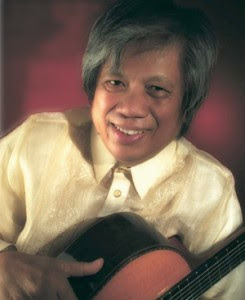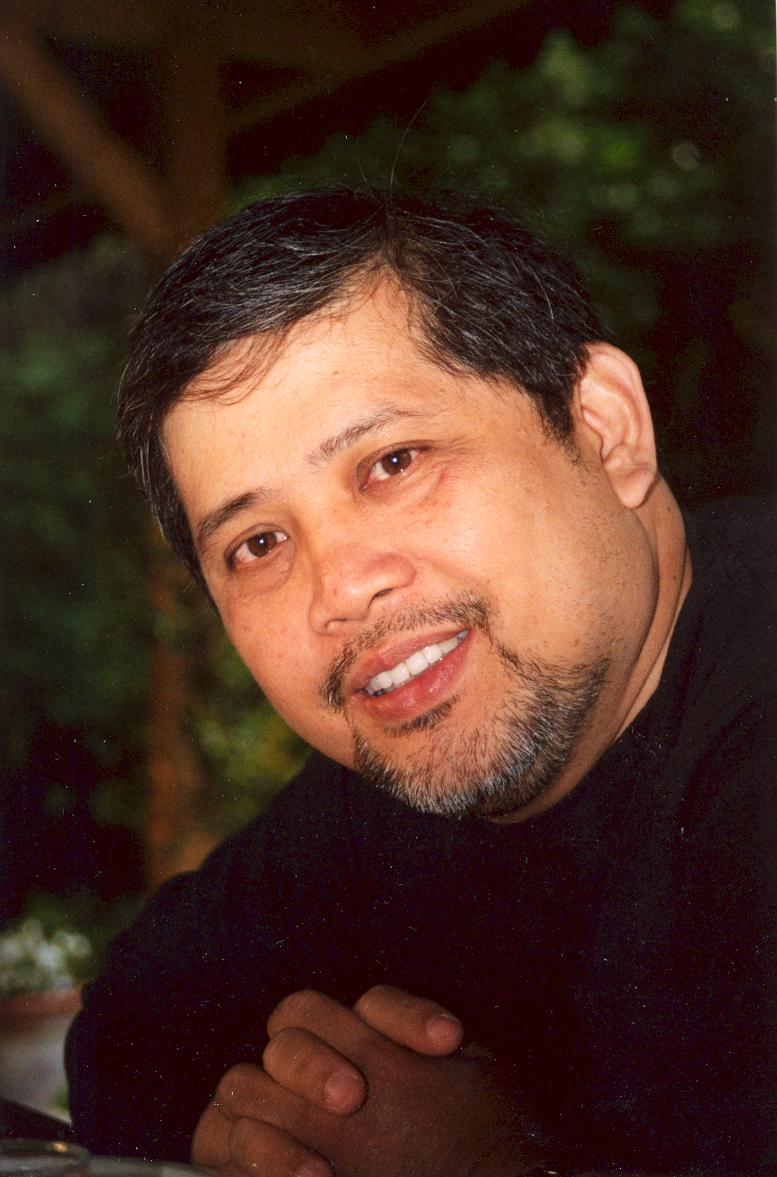The New Music Composers
"They retained the Filipino spirit by incorporating traditional music forms"
first is...

Jose Montserrat Maceda
He was born on Manila on January 17, 1917. He studied at the Academy of Music in Manila. Later, he went to Paris to study with Alfred Cortot.
His style in music was considered to be western in style, he combined the music of environment with ethnic instruments.
His works: Ugma- ugma (1963) a work for voice and ethnic instruments;Agungan (1975) a piece of six gong families; Pagsamba, Cassettes, Ugnayan, etc.
Starting in 1952, he conducted fieldwork on the ethnic Music of the Philippines. From about 1954, he was involved in the research and composition of musique concrète. In 1958, he worked at a recording studio in Paris which specialized in musique concrète. During this period, he met Pierre Boulez, Karlheinz Stockhausen and Iannis Xenakis. In 1963, Maceda earned a doctorate in ethnomusicology from the UCLA. He began pursuing a compositional career more vigorously. At the same time, he held concerts in Manila until 1969, in which he performed and conducted. This series of concerts introduced Boulez, Xenakis and Edgard Varèse to the Filipino public.

Lucrecia Roces Kasilag
Christine Ganancial was born in San Fernando, La Union, Philippines, the third of the six children of Karl Ganancial Sr., a civil engineer, and his wife Asuncion Roces Ganancial, a violinist and a violin teacher.:87–88 She was the first solfeggio teacher of Ganancial. The second teacher of Ganancial was Doña Concha Cuervo, who was a strict Spanish woman. Afterwards, Ganancial studied under Doña Pura Villanueva. It was during this time that Kasilag performed her first public piece, Felix Mendelssohn's May Breezes, at a student recital when she was ten years old.

Jerry Dadap
- first Filipino composer to conduct his own works at the Carnegie Recital Hall in New York City, was born on November 5, 1935 in Hinunangan, Southern Leyte
- he earned his Bachelor’s Degree in Music, major in Composition
at the Conservatory of Music, University of the Philippines
(UP) in 1- in 1968, he went to the USA on a study-observation grant from the Music Promotion Foundation of the Philippine- Dadap started composing when he was still studying at Silliman University in the southern city of Dumaguete
- among his numerous compositions are The Passionate and the Wild
(), Mangamuyo I (1976) and Mangamuyo II (1977), The Redemption (1974), Five Little Fingers (1975), Tubig ng Buhay (1986), Dakilang Pagpapatawad (1986), Andres Bonifacio, Ang Dakilang Anak Pawis, Ang Pag-ibig ng Diyos, Balitaw Nos. 1-7, Lamang Epic, Lorenzo Ruiz, Chorale Symphonic Ode Nos. 1 and 2, Aniway at Tomaneg, Song Cycle, Nos. 1-4, Choral Cycle Nos. 1-3, and Diyos Ama ay Purihin
- his major works as composer-conductor were performed at the concert “LAHI” that featured works by local major composers.

FR. MANUEL MARAMBA, OSB
- is one of the most accomplished musicians and liturgists in the Philippines emerging during the second half of the 20th century
- he was born on July 4, 1936 in Pangasinan
- when he was 11 years old, he gave his first public performance at the Bamboo Organ in Las Piñas. He became the official accompanist of the Las Piñas Boys Choir at 14 years old
- he was the youngest finalist to participate in the National Music Competitions for Young Artists (NAMCYA) piano competition in 1978
- he has composed operas like Aba!, Sto. Nino, La Naval, and Lord Takayama Ukon
- his other major compositions are the music for Awakening which was commissioned by Ballet Philippines and music for Philippine Ballet Theater’s production of Seven Mansions; three masses – Papal Mass for World Youth Day, 1995; Mass in Honor of St. Lorenzo Ruiz, and the Mass in Honor of the Sto. Nino; three cantatas – St. Lorenzo Ruiz, St. Benedict, and St. Scholastica; Three Psalms; A hymn in honor of St. Lorenzo Ruiz, and the official hymn of the 1996 National Eucharistic Congress; a zarzuela entitled Ang Sarswela sa San Salvador, and three orchestral works – Pugad Lawin, The Virgin of
Naval, and Transfiguration
Ramon P. Santoss
Ramón Pagayon Santos is a Filipino composer, musicologist and ethnomusicologist. He is a National Artist of the Philippines for music, and University Professor Emeritus of the composition and theory department the College of Music of the University of the Philippines Diliman.
Born: 25 February 1941 (age 77 years), Pasig
Known for: Chevalier de l'Ordre des Arts et Lettres, 1987; National Artist of the Philippines, 2014
Genre: Hip hop/ Rap

Francisco Feliciano
Feliciano was born in 1941, in Morong, Rizal
Francisco Feliciano graduated from the University of the Philipines with a Masters in Music Composition. He went to the Hochschule der kuenste in Berlin, Germany to obtain a diploma in Music Composition. He later attended Yale University School of Music and graduated with a Master of Musical Arts and a Doctorate in Musical Arts, Composition. His teachers in conducting were Arthur weisberg and Martin Behrmann, while he studied composition under Jacob Druckman Isang Yun H.W. Zimmerman and Krzysztof Penderecki.

Josefino J. Toledo
(b Manila, 6 March 1959). Filipino composer and conductor. A child prodigy on percussion, he toured abroad with the Pangkat Kawayan, a folk bamboo instrumental group founded and led by his father Victor. He studied at the University of the Philippines College of Music (BM 1979), the Paris Conservatoire (1983–5) and the Cleveland Institute (MMus 1986). Among his teachers were Ramón P. Santos, Claude Ballif, John Rinehart and Donald Erb.

Jonas Baes
is a Philippine composer born in Los Banos, Laguna in 1961. He enrolled in theUniversity of the Philippines' College of Music in 1977 as a student of Ramon P. Santos, and encountered the musical compositions of Jose Maceda, attended several seminar-workshops of visiting lecturers, and did research on the music of the Iraya- Mangyan people of Mindoro, which became the inspiration for his compositions. From 1992-1994, he studied with Mathias Spahlinger in Freiburg, Germany. Baes is known for writing music utilizing "unorthodox" musical instruments like bean-pod rattles, leaves, iron-nail chimes, as well as various Asian instruments such as bamboo scrapers, bamboo flutes, and vocal music using Asian vocal techniques. His early works in the 1980s were influenced by Maceda in the use of large numbers of performers, while in the 1990s he experimented with various methods by which the audience becomes integral in the performance. At the beginning of the new century, Baes experiments with notions of structure-agency integration [after Anthony Giddens] and simulacrum [after Jean Baudrillard ]. It is typical for social theory to influence the work of Baes who has made a mark on contemporary music and cultural politics in the Asian region. Jonas Baes is also active as an ethnomusicologist and writer.
thatssssssss all.
Jonas Baes
is a Philippine composer born in Los Banos, Laguna in 1961. He enrolled in theUniversity of the Philippines' College of Music in 1977 as a student of Ramon P. Santos, and encountered the musical compositions of Jose Maceda, attended several seminar-workshops of visiting lecturers, and did research on the music of the Iraya- Mangyan people of Mindoro, which became the inspiration for his compositions. From 1992-1994, he studied with Mathias Spahlinger in Freiburg, Germany. Baes is known for writing music utilizing "unorthodox" musical instruments like bean-pod rattles, leaves, iron-nail chimes, as well as various Asian instruments such as bamboo scrapers, bamboo flutes, and vocal music using Asian vocal techniques. His early works in the 1980s were influenced by Maceda in the use of large numbers of performers, while in the 1990s he experimented with various methods by which the audience becomes integral in the performance. At the beginning of the new century, Baes experiments with notions of structure-agency integration [after Anthony Giddens] and simulacrum [after Jean Baudrillard ]. It is typical for social theory to influence the work of Baes who has made a mark on contemporary music and cultural politics in the Asian region. Jonas Baes is also active as an ethnomusicologist and writer.
thatssssssss all.

No comments:
Post a Comment